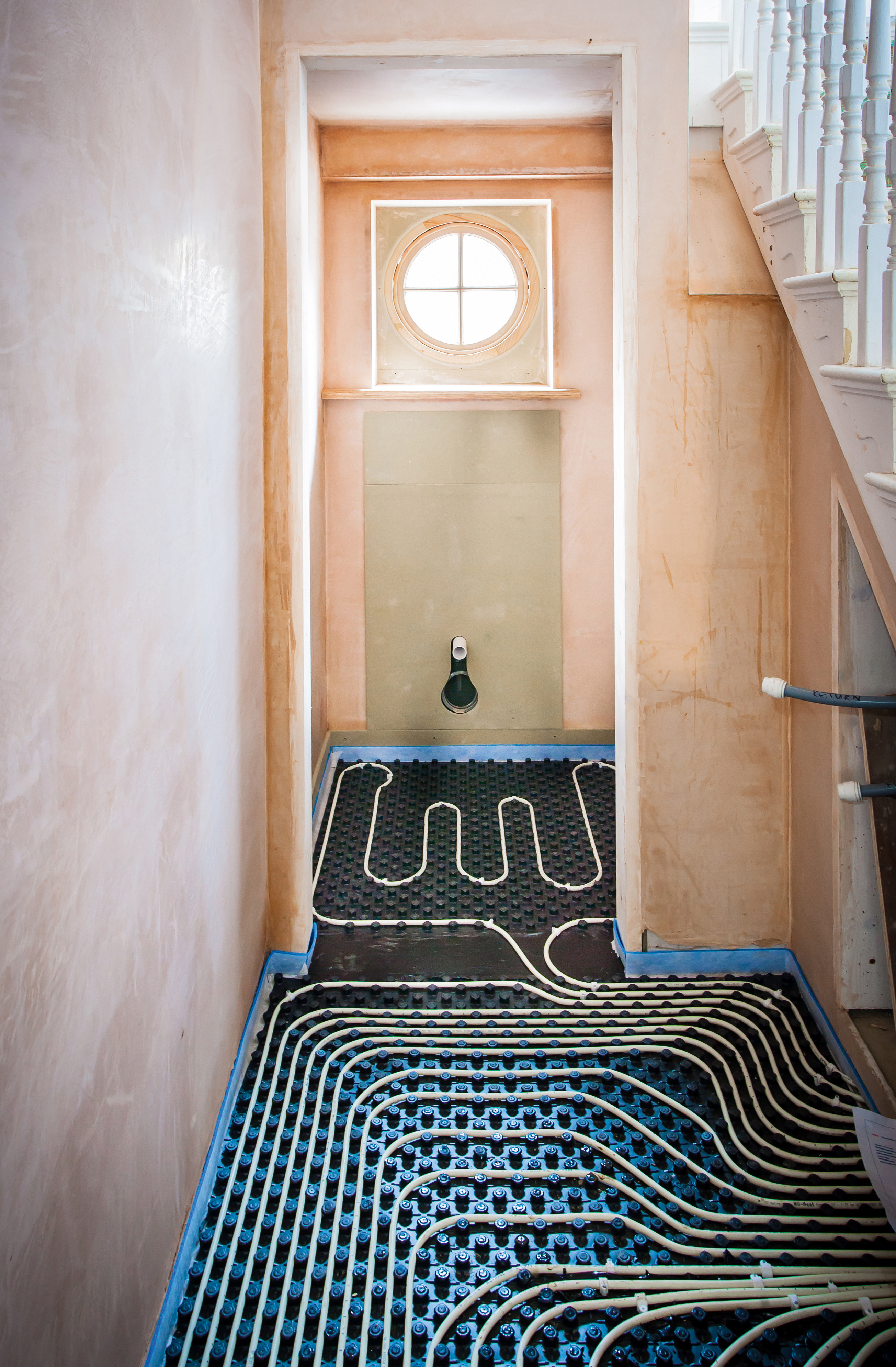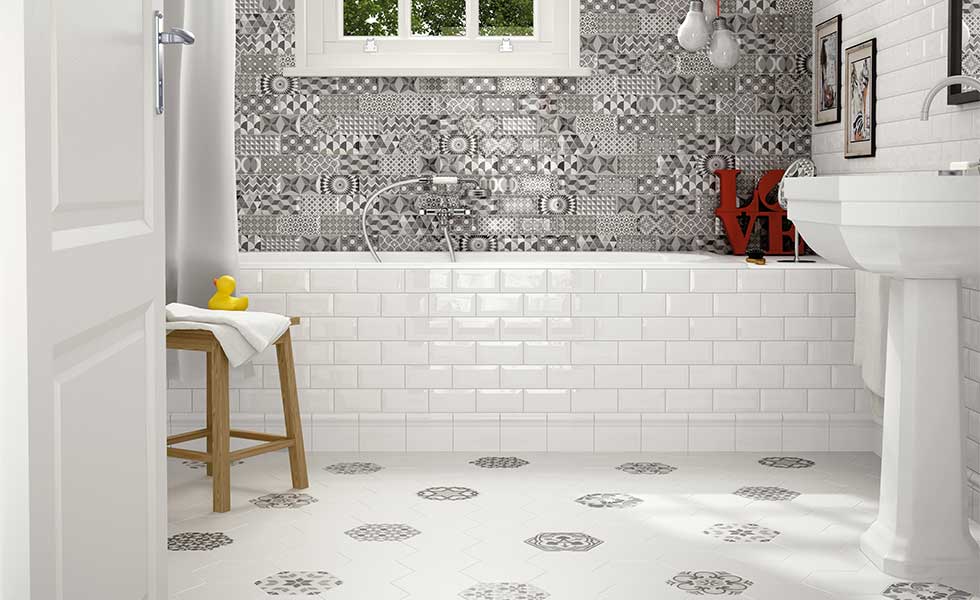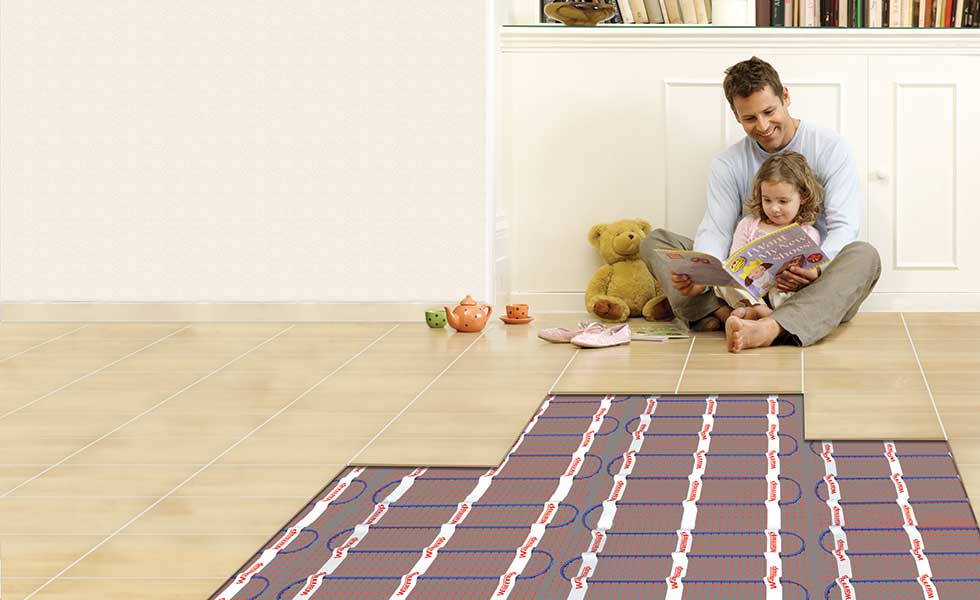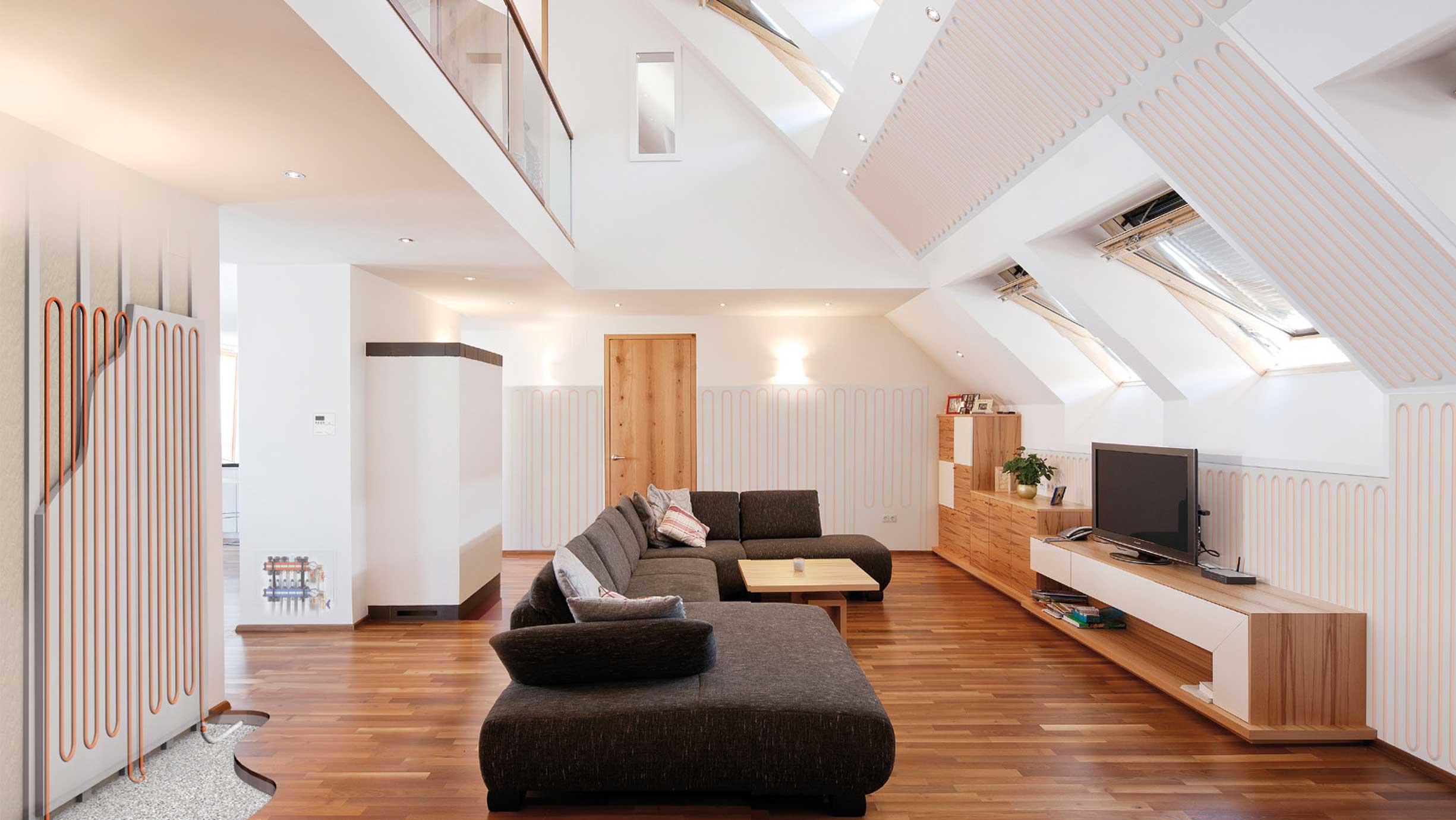How To Install Easy Heat Pipe Cable
Underfloor heating (UFH) is an increasingly popular way to warm a home, and it'due south not difficult to see why. UFH provides comfortable heat, it saves space, and it ensures flooring such equally tiles and rock are warm underfoot.
Add to the list of benefits the fact that underfloor heating is as well a neat partner to a heat pump, and plumbing fixtures them both in a new domicile, or when you're embarking on major renovations, tin be a audio strategy.
But if you're considering plumbing fixtures underfloor heating in your home, it's vital to know if it is a suitable option for your item property. And you might likewise exist wondering if it can exist used alongside other types of heating. And, of course, underfloor heating cost is definitely going to exist on your listing of questions.
Here, nosotros're answering all the queries you might have about everything from underfloor heating installation costs to which types of floor it's compatible with, and nosotros've asked the experts to provide their summit tips, likewise.
How does underfloor heating work?
Underfloor heating comes in ii types. Moisture, which is so chosen considering hot water is pumped through pipes in the flooring, or dry, which is the name used for electric systems that run off the mains. Wet systems are fed by hot water often heated by a boiler, only likewise work well with renewables such every bit solar panels or heat pumps.
Both methods heat the flooring so that it emits heat to the room. A radiator, by comparison, has a much smaller surface area, and besides needs the h2o to heated to a much college temperature than a wet UFH organisation requires.
How much does it cost to install floor heating?
Expect to spend upward of £120 per foursquare metre for wet systems and from £50 per square metre for electric, according to Checkatrade. Overall, the tradesperson-recommendation site says underfloor heating installation and materials from a professional volition cost anywhere betwixt £500 and £8,000.
Costs volition depend on the type of underfloor heating yous select, and you lot should bear in listen that electric systems are far less expensive to install for areas upwards to twenty foursquare metres. Checkatrade offers the following guide:
Electrical underfloor heating price
New-build install: £50 to £75 per square metre
Renovation property: £sixty to £85 per square metre
Wet underfloor heating installation cost
New-build install: £120 to £135 per foursquare metre
Renovation property: £135 to £185 per square metre
Is it expensive to run underfloor heating?
Underfloor heating isn't expensive to run when compared to other options. 'Underfloor heating offers many benefits including distributing heat beyond the home evenly, something that not all wall radiators can do,' says 'Mike Fairman, CEO of Checkatrade. 'About underfloor heat systems can also heat a room more effectively on a lower heat too, saving y'all money also over time.'
And you might be wondering specifically: is underfloor heating cheaper than radiators? 'On a technical level, UFH input temperatures can be as low as forty°C, using a lot less energy/fuel to estrus a radiator that typically requires temperatures of 70 to 90°C,' says Tom Edmunds, general director Wunda Group.
Compared to a radiator-only heating system, UFH is estimated to be 25 per cent more than efficient when paired with a modern condensing boiler, and up to 40 per cent more efficient when combined with a oestrus pump.
What about electrical underfloor heating costs? 'Underfloor heating systems are generally not too expensive to run – 1 square metre of standard underfloor heating can operate at full power for upwards to half dozen hours at running costs below 10p,' says John Klee, marketing executive at BestHeating of this type. 'Furthermore, electric underfloor heating (UFH) systems can be controlled via remote thermostats to ensure they are simply in use when admittedly necessary.'
Which type of underfloor heating is best?
DID YOU KNOW?
Compared to a radiator-only heating system, UFH is estimated to be 25 per cent more efficient when paired with a modern condensing boiler, and up to 40 per cent more efficient when combined with a heat pump.
Although the ii master types of underfloor heating are moisture and electric, at that place are alternative wet systems on offer. Renovation skilful Jason Orme gives the lowdown on all the options and their pros and cons.
Warm water cached underfloor heating
Warm-water systems involve burying ane.6cm pipes into the floor screed. The screed is then finished in your selected covering and the zoned system controlled by a manifold, usually located in a store cupboard. Rather than radiators emitting heat, the whole floor slab does and then.
Pros Most free energy-efficient style of delivering UFH. Low running costs.
Cons Requires a complete overhaul of the existing floor structure and and so best suited to extensions or new builds.

This LoPro Max surface-mounted water system has low running costs compared to an equivalent electric UFH system. For case, a 30m 2 electric underfloor system would price about £720 per annum to run, while LoPro Max costs £240 when working with a gas boiler. Single-room, 4m 2 kit, from £970.80, Nu-Heat
(Image credit: Nu-heat)
Warm water surface-mounted underfloor heating
If y'all don't desire to dig out the floor structure, consider underfloor heating systems from companies such as Nu Oestrus and Polypipe. These consist of insulated panels with channels routed out for 1.2cm pipes to sit in, which can be laid on top of the existing flooring structure. The panels add as piddling as 1.5cm to the floor height and apply warm h2o in the aforementioned style as the buried systems.
Pros Easy-to-fit low-contour arrangement.
Cons Relatively expensive and adding this organization to selected rooms that are office of one storey of a habitation will cause level changes between the spaces.
Electric
An electric arrangement avoids the need to raise floor levels in existing rooms, and is a popular selection for heating single rooms. Electric systems consist of matting on to which cables connect into the abode's electric circuit. It is operated via thermostats. Electrical UFH mats are slim and can exist laid within tile agglutinative, making them very popular for bathrooms.
Pros Easy to retro-fit. Ideal for individual rooms. Cheap to install.
Cons Relatively loftier running costs compared to water systems.

Tiled floors are ideal for use with UFH due to their low thermal resistance and high thermal mass. Hexagon flooring tiles, from £29,95 per thousand 2 , and Mono Patchwork wall tiles, £49.95 per 1000 ii , both Walls and Floors
What are the other pros and cons of underfloor heating?
Nosotros asked the experts to tell the states the benefits of underfloor heating, besides as explaining whatever possible downsides.
'Equally electric systems are installed directly under the floorcovering, and piece of work independently from your central heating organisation, they are especially useful for i-room installations or where the sub-flooring level is already set,' says Martin Conway, technical services managing director at Pimlico Plumbers. 'The wire or matting systems are very thin (around 3mm) and shouldn't cause problems with differing floor levels – thus creating little disruption to the existing room.
'Wet systems circulate warm water through plastic pipes installed underneath the floor and are connected to the primary central heating source. This arrangement tends to work best when the pipes are embedded in a screed, as this helps dissipate the heat, so it is suited to new floor constructions where the sub-flooring can adjust the pipework and cement screed. Wet systems are therefore more likely to be used in new-builds and extensions or during major renovation work.'
Some other advantage of UFH is that information technology'due south space-saving. 'By removing radiators, y'all will proceeds up to xv per cent more usable flooring space inside a dwelling house,' says Tom Edmunds. 'You are no longer spring by radiator positioning when styling a room'due south layout and you tin can furnish with liberty. It'southward an interior designer'southward dream scenario.'
UFH has other plus points. 'Underfloor heating operates silently and out of sight, and is tamper-proof and child friendly – no hot surfaces,' he adds.
What kind of insulation does underfloor heating need?
The type of flooring insulation you require volition depend on the kind of arrangement you have called.
For ground-floor rooms and renovation projects with a solid flooring construction, UFH systems will need to be laid directly onto pre-installed foam or polystyrene-blazon insulation, in order to meet building regulations.
There are also systems for solid floors that contain insulation into their organization design, such as Polypipe's floating floor organization, which features high-density polystyrene flooring panels that provide the base for the heating pipes, but likewise enhance insulation.
For rooms upstairs, the insulation y'all require will one time again depend on the product you lot have called. These slightly trickier installations crave underfloor heating systems that can exist installed on to floors without a solid base, often on suspended timber or battened surfaces. Here, we would always recommend using a solution that incorporates insulation into its design, so you lot can be sure that the insulation is the perfect fit for your organisation's requirements.
For example, Polypipe's suspended floor system features insulation specifically designed to fit between supporting joists, while its modular heating panels solution is a organisation made up of pre-configured panels with 3cm of insulation already built in with the panels able to exist but connected so installed between joists on site.
Is underfloor heating the best option for my home?
UFH is peculiarly constructive for large open-plan spaces – specially those with high ceilings – as the entire floor radiates heat upwards warming feet and creating even room temperatures. This radiant rut also ways reduced draughts, wet levels and airborne allergens.
Typically, underfloor heating is more than than enough as a standalone class of heating. However, its capabilities will ofttimes be dictated by other factors, such as flooring coverings (see below) and a edifice's insulation levels (especially walls and windows). This is why oestrus-loss calculations are and then primal, and the edifice'due south individual thermal performance will indicate how much oestrus you need to generate.
For example, a poorly insulated room with lots of glazing may not heat fully when it is cold outside (which means boosted insulation or supplementary heating may be necessary).
There is a limit to the floor temperature an underfloor heating system can operate at comfortably, and then this can mean it's not suitable for very small rooms where the ratio of floor area to room volume is depression.
Underfloor heating is a good choice for heating your kitchen, peculiarly an open program, living kitchen. It works well with hard floor often used in a kitchen and means you lot can use wall space for storage instead of radiators.
Is underfloor heating suitable for an old home?
UFH can be a sound choice for an old house. However, it'due south not suitable if a historic floor would be damaged, or the foundations undermined. Remember as well that concrete floors and damp-proof membranes may upset the equilibrium of the structure, causing damp issues. An culling, breathable pick is Limecrete. This works particularly well with underfloor heating and includes a compatible layer of insulation.
Bear in mind, besides, that UFH may not have sufficient output to heat a large old property with little insulation.
Is it cheaper to exit underfloor heating on all the time?
Whether it'due south cheaper to leave underfloor heating on all the time depends on the organization and the time of year. Be aware, though, that to ensure your home is comfortable, you volition need to factor in a longer warm-up time compared to a radiator system with some types of UFH.
'You don't demand to leave underfloor heating on all the time,' says Tom Edmunds. 'Hassle free dry-prepare systems – such as Wundatherm – are laid direct on superlative of the existing flooring and strong enough to support any floor finish you desire. The system comprises of stiff polystyrene boards capable of rapid heat-upwardly times (as fast equally 35 to xl minutes) supporting tile finishes, or castellated console systems with reinforced designs that require much less screed (around 35mm).'
Tin can I combine warm h2o underfloor heating and radiators?
A combination of both systems can be the answer for many homes, every bit radiators can be easily incorporated into an underfloor organization.
A skillful compromise is to install underfloor heating on the ground floor, with radiators upstairs to conform the different requirements for living and sleeping spaces, especially as many people nonetheless want heated towel rails in their bathrooms.
How easy is underfloor heating to control?
Specialist UFH controls are vital to ensure comfort, responsiveness and energy efficiency. Underfloor heating takes longer to heat upwardly and absurd downward compared to radiators, so to overcome this fourth dimension lag, programmable controls are essential.
For households with irregular or express occupancy and for holiday homes, it is useful to take remote command and so that you tin can turn the heating on an hour or two before arriving. Remote control is likewise useful if you forget to plow the heating off.
How to choose the right heat output
Your heating engineer or UFH supplier will design the organisation for you, matching the output per foursquare metre to the heat requirement of the room, based on volume, heat loss characteristics of the walls, flooring, roof, windows and ventilation, and your choice of floor covering.
Which types of floor and sub-floor are best with underfloor heating?
There is a wide range of floor that tin can be used with UFH. 'If you're moving over to underfloor heating, you'll need to consider which flooring you squad with information technology,' says Jessica Flim-flam, senior communications executive at Flooring Superstore. 'Engineered hardwood flooring can look as good every bit real wood. Other options like vinyl and rug are likewise suitable.'
For well-nigh efficient oestrus transfer, nonetheless, opt for natural rock flooring, or porcelain or ceramic types of tiles. Polished screed and resin floors also take a very loftier heat transfer level. Vinyl and linoleum, laminate, and engineered forest can also be suitable, every bit can carpet. Do bear in listen that the latter should be teamed with an underlay with a tog value of less than 1.3, co-ordinate to the Rug Foundation.
The best type of flooring sub-construction is i made from screed that fully encapsulates the pipework and provides a dense and conductive medium for the spread and emission of the heat flowing through the pipes. This then allows a lower temperature to exist used, typically around 35°C, and makes for a much more efficient UFH arrangement.
- Find out more about vinyl flooring .
What's the installation process for underfloor heating?
Electric underfloor heating systems can hands be installed by a competent DIYer, although the majority of projects are still completed by a contractor, such as a tiler or electrician.
About UFH systems are laid on insulation with a screed roofing. In this state of affairs, laying the pipework and connecting the manifolds can exist carried out by any competent person.
If y'all're doing this yourself, your chosen company should provide pipe layout drawings for you to follow, along with installation manuals or videos roofing a similar projection. It is simply a matter of following the pipework drawings – running each individual excursion from the manifold, clipping the pipe to the floor with the provided staples, and so returning the pipework to the manifold. All installations should exist tested before the terminal floor cease is laid.
A qualified installer is needed for electrical or gas connections.
How to measure up
Standard UFH systems are fifteen to 16.5cm in depth, comprising 10cm of insulation, 5 to half dozen.5cm of screed containing the warm water pipes, followed past the flooring end.
Can underfloor heating leak?
Unless a nail is accidentally put through the pipes at some stage, this does non happen. At that place are no joints in the floor and the pipes are designed and tested to have a l yr life expectancy at temperatures and pressures that exceed those required by the organization.
If accidental damage should occur, individual pipes tin be pressure tested to locate the correct ane. In timber floors, the piping can unremarkably be exposed to allow for repairs, while screed floors will demand to be excavated to uncover the pipe. When it comes to electric systems, it is simply a case of lifting the floor covering and replacing the damaged excursion.
Does underfloor heating come with a warranty?
Look for systems that come up with an extended warranty as standard. Wet systems consist of various components, and you may observe different lengths of warranty are offered on each part – for example, 25 years on pipes, but perhaps two years on the manifolds. As a general rule, manifolds are simpler to supplant than pipes, so a long warranty on the pipes themselves is highly desirable.
With electric systems, extended warranties are normally in the order of one twelvemonth for the thermostats, which are easily replaceable, and 10 years for the heating cables, which are non. Lifetime warranties are likewise available with some brands.
When looking at warranties, do ensure that the visitor backing it has some substance. A number of online companies have sprung upwards offer extended warranties on their systems, just if they are no longer in existence when the system fails so that warranty will be worthless.

The Sticky Mat electric underfloor heating organization from WARMUP PLC. with force per unit area sensitive adhesive for speedy, low-profile installation. From £48.92 per one thousand² excluding VAT
Are there other invisible heating systems?
As an alternative to underfloor heating, you could consider both skirting lath systems and wall panel heating.
Skirting board heating
Wet or electric skirting heating systems are a bully option. Wet systems can be used with heat pumps every bit well as conventional boilers due to their large surface area and the fifty-fifty distribution of heat effectually rooms.
Direct electric versions are easier and simpler to install into backdrop with no existing gas or pipework, but are more expensive to run. However, their fast response times and even heat distribution does offset some of the additional costs when compared to other forms of electrical heating.
Installation of a skirting board heating organization in a typical 2 bedroom semi-discrete house would price upward of between £3,600 and £half dozen,000, although cheaper, DIY supply-but options are available; expect to pay upwards of £500 to £720 per room.
Wall panel heating
Variotherm modular wall and ceiling heating panels are a solution for rooms where underfloor heating is not an choice, whether in renovations or new builds. They are easily adaptable for walls, sloping ceilings and circuitous roof structures. Full systems start from £70 per square metre, including the manifold, boards and controls, at supplier UFH1.

Variotherm modular wall and ceiling heating panels
(Image credit: Variotherm)
Source: https://www.realhomes.com/advice/underfloor-heating-your-questions-answered
Posted by: williamsontooll1944.blogspot.com


0 Response to "How To Install Easy Heat Pipe Cable"
Post a Comment